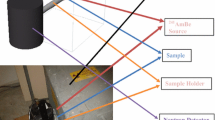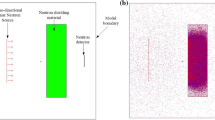Abstract
The leakage of fusion neutrons from ITER tokamak machine would cause bio-shield activation. Assessment of the shutdown dose rate from activated bio-shield is necessary from the standpoints of occupational safety. FISPACT inventory calculations have been performed for four different types of the bio-shield concrete under the neutron irradiation of ITER and ASP, which is a 14 MeV fusion neutron irradiation facility in UK. Shutdown contact dose rate and the dominant radioactive isotopes of each sample have been evaluated and cross compared for different concretes for ITER and ASP irradiations. The results show that activation products of same concrete are different under irradiation of predicted ITER moderated neutron source and ASP fast neutron source. Fast neutron activation leads to high dose rate dominated by 24Na for about 1 day after shutdown and it shows insignificant impact of impurities on dose rate. While moderated neutron activation leads concretes with impurities to a relative high dose rate for a long cooling time. These radiological hazard elements in impurity have been listed.
Similar content being viewed by others
Avoid common mistakes on your manuscript.
Introduction
A biological shield (Bio-shield) of 2 m thick concrete is provided around the ITER cryostat to limit the radiation levels outside the pit to value insignificant for the activation of components [1]. However, the activation of bio-shield itself and accompanying shutdown dose rate must not be neglected especially at position of the equatorial bio-shield plug where the amount of leakage neutrons is largest. An assessment of the activation characteristics of the bio-shield is necessary from the standpoints of occupational safety and structural design of the tokamak building. The means of study of concrete activation involves activation calculations using transport codes and inventory codes and preferably, an activation experiment at neutron irradiation facility. The previous research on concrete activation can be traced to activation of the concrete in the bio-shield of ITER, Kalcheva [2] and experimental studies of concrete activation at the National Ignition Facility using the rotating target neutron source, Belian et al. [3]. Their method of activation calculation and experiment approach is still useful in current activation study; however the computational model, data and code are obsolete. This study mainly aims at determining whether an experiment at ASP [4] would show up the important activation products that would be produced at ITER. Based on neutron spectrum and total neutron flux calculated by transport code from updated computational model, an inventory calculation has been performed to evaluate shutdown contact dose rates and dominate radioactive isotopes of four concrete types for ITER and ASP. The detail results and discussion have been listed in the third section.
Methodology and Material
The principle of activation calculation is to compute the neutron flux through concrete sample and then to determine the activation of the material within it. The first step was accomplished using the Monte-Carlo code MCNP [5] and the second using FISPACT-2007 [6] with EAF-2007 activation cross sections library [7].
In the ITER case, the calculated neutron flux and neutron spectrum at position behind mid-diagnostic port were used for inventory calculation [8]. The flux and spectrum represent the highest levels and most energetic neutron which the bio-shield will be subjected to therefore the results presented below are the maximal levels of dose that would be obtained. The total neutron flux is 1.6 × 1018 n/cm2 s and neutron spectrum is illustrated in Fig. 2. The SA2 irradiation scenario [9] is used in activation calculation.
In the ASP case, the neutron source flux is calculated by MCNP code previously according to ASP neutron source definition [10]. Figure 1 shows three plane views of neutron flux based on a Cartesian coordinate whose origin is center of neutron source. Emitting neutrons are isotropic on the XZ plane but with an energy-angular tendency along the Y axis. The irradiation position of concrete sample is assumed at 0.6 cm far away from origin in Y axis plus direction. The dimension of concrete sample is defined as a cube with side lengths of 3 cm. The neutron spectrum in sample was calculated by MCNP in the standard VITAMIN-J 175 group structure, shown in Fig. 2. The total neutron flux is 4.8 × 1019 n/cm2 s. One hour continuous irradiation is assumed in activation calculation.
Four kinds of concrete samples labeled as G1, L2n, NBS04 and Barytes were chosen for activation calculation in this study.
G1 and NBS04 are the ordinary concretes with the approximate concentration of major constituent elements except for the sample G1 considering up to thirty minor constituent elements (impurities) in composition. Barytes is a typical heavy concrete with high concentration of barium (BA 46.34 %). The sample L2n is also a kind of ordinary concrete considering ~30 impurity elements. Different with others, it contains 4 % volume fraction of iron as the reinforcing steel bar. Additional, 0.2 % weight fraction of cobalt as impurity in iron is considered.
The detail constituent elemental concentrations of concrete samples could be referred to Tables 1 and 2 in Ref. [11] for the sample G1 and L2n as well as to the table. 8.8 in Ref. [12] for the sample NBS04 and Barytes.
Results and Discussion
The shutdown contact gamma dose rate of each sample is plotted in Fig. 3. The solid lines and dotted lines represent the dose rate as a function of cooling time in ASP case and ITER case respectively. The different colors represent different samples. The dominant radioactive nuclides and their pathways of each sample are listed in Tables 1, 2, 3 and 4 for both cases.
From the above results, several phenomena would be observed. Firstly, in view of tendency of dose rate versus cooling time, it shows that at the first cooling day (105 s), dose rates of samples in ASP case are apparently higher than those in ITER case because of high total neutron flux and fast neutron spectrum. The dominant nuclide at this period is 24Na produced via pathways of 27Al (n, α) and 24Mg (n, p) for all samples in ASP. However, with decay of 24Na, the dose rate deceased steeply by about two orders of magnitude at the end of the twelfth day (106 s), while as for the dose rate of all samples in ITER case except for that of NBS04 (blue dashed line), their dose rates reduced slightly. It is also noted that dose rate of L2n keeps almost a constant level for about 10 years after shutdown because of 60Co dominated dose rate by pathway of 59Co (n, γ). Secondly, the difference of dose rate between concretes with and without impurity is more apparent in the ITER case than that in ASP case. For example, G1 and NBS04 have similar major constituent elements except G1 includes impurity, while the difference of dose rate between G1 and NBS 04 is up to 95 % in ITER case by comparing with 47 % in ASP case at end of 12th cooling day. The reason is that some nuclides in impurities such as 59Co, 153Eu and 133Cs have very large absorption cross section for thermal neutrons by (n, γ) reaction as well as a relative long half-life (several years). Therefore, the concentration of these radical hazard elements should be as low as possible in order to control the shutdown dose rate. Finally, from the occupational safety point of view, dose rates outside the bio-shield should be less than 10 µSv/h 24 h after shutdown [13]. It is noted that dose rate of Barytes is the lowest one both in ASP and ITER case at the end of first cooling day.
Conclusions
The activation characteristic of bio-shield with different concrete compositions has been estimated using the inventory code FISPACT under the ITER and ASP irradiation scenario respectively. Four typical concrete samples have been chosen for activation analysis. Some conclusions are listed as following.
-
The high neutron flux with a large amount of fast neutrons leads to a high shutdown dose rate for all concrete samples at end of the first cooling day in ASP case, but their dose rates will decease rapidly along with the decay of dominant nuclide 24Na.
-
Some elements of impurities such as Co, Cs and Eu have high absorption cross section of thermal neutrons. Their activation products have high radiological hazard as well as a relative long half-life. It should limit the concentration of above elements to as low as possible value.
-
The heavy concrete (Barytes) shows the low shutdown dose rate as well as the good gamma shield competence.
References
ITER Director, Summary of the ITER final design report, ITER IDM G A0 FDR 401-06-28 R 0.2 (2001)
S. Kalcheva, Activation of the concrete in the bio shield of ITER. SCK-CEN, Boeretang 200, 2400 Mol (Belgium) (2005)
A.P. Belian, J.F. Latkowski, E.C. Morse, Fusion Eng. (1997). doi:10.1109/FUSION.1997.687013
N. Bainbridge, ASP particle accelerator. Discovery 9, 30 (2004)
X-5 MONTE CARLO TEAM, MCNP-Manual (Version 5, Vol. I), Los Alamos National Laboratory. Report LA-UR-3-1987 (2003)
R.A. Forrest, FISPACT-2007 User Manual. UKAEA FUS 534 (2007)
R.A. Forrest, J. Kopecky, J.C. Sublet, The European activation file: EAF-2007 cross section library, UKAEA FUS 535/537 (2007)
M.J. Loughlin, Activation of aluminium, ITER IDM JNKMWF (2013)
M.J. Loughlin, N.P. Taylor, Recommendation on plasma scenarios, ITER_D_2V3V8G (2009)
L.W. Packer et al., Fusion Eng. Des. 87, 662 (2012)
M.R. Christopher et al., Radioanal Nucl. Chem. 291, 267 (2012)
J.K. Shultis, E.F. Richard, Radiation Shielding. (Amer Nuclear Society, Santa Fe, 2000) P.305
H. Iida, V. Khripunov, L. Petrizzi, et al., Nuclear Analysis Report (NAR), ITER IDM G 73 DDD 2W 0.2 (2004)
Acknowledgments
This work was provided by the National special project for magnetic confined nuclear fusion energy of Grant No. 2013GB108004. We are grateful for the precious suggestions providing by Dr. Michael Loughlin and Dr. Eduard Polunovskiy from ITER IO.
Author information
Authors and Affiliations
Corresponding author
Rights and permissions
About this article
Cite this article
Li, J., Liu, S., Zhao, P. et al. Activation Analysis and Comparison of Bio-shield Under ITER and ASP Neutron Irradiation. J Fusion Energ 34, 727–732 (2015). https://doi.org/10.1007/s10894-015-9850-6
Published:
Issue Date:
DOI: https://doi.org/10.1007/s10894-015-9850-6







